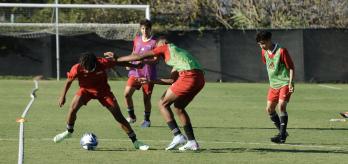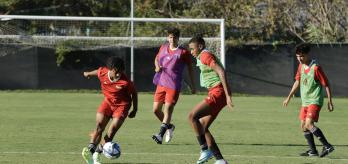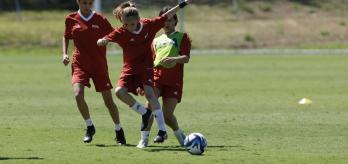Methodology
What is practised?
This attack v. defence exercise simulates a 2v1 scenario in which a defender finds themselves isolated and must decide whether to press the receiving player or hold their position. The defender must pay attention to the pass and the receiver’s first touch to help them to decide whether they should press aggressively or hold their ground. Adopting a low, side-on body shape and being light on their feet helps the defender to adjust quickly to their opponent’s movements. The defender should get touch-tight to their opponent without committing a foul. Additionally, the defender must be conscious of not giving the attackers a clear route to goal and must retreat diagonally so as to reduce the distance to goal.
For whom is this relevant?
This exercise revolves around the player scale, focusing on a player’s ability to prevent opponents from playing past them when outnumbered. The drill is particularly relevant to players who find themselves in situations in which they are isolated and up against two attackers. The scenario applies to numerous phases of the game, including when the player is the last line of defence and attempts to deny a goalscoring chance or is isolated in midfield and tries to prevent the opposition from progressing play into the final third.
How is the practice designed?
This drill involves a 2v1 attack v. defence scenario that is designed to enhance a defender’s decision-making skills and heighten their awareness of their opponent’s subtle actions in such scenarios. The pass played into the player situated along the side of the exercise area and the players’ starting positions are designed to trigger a split-second decision from the defender, with the size of the exercise area limiting players to short movements and actions. The mini-goal serves as an objective for both the defender, who is asked to defend it, and the attackers, who are tasked with scoring into it. The exercise is not specifically position-based and focuses more on defensive actions that can be implemented across all areas of the pitch.
Session plan
Organisation
-
Mark out a 20m x 10m exercise area with an imaginary halfway line using cones. Place a mini-goal centrally and 3 metres beyond one end of the exercise area.
-
Position a cone centrally and 3 metres beyond the opposite end of the exercise area. Place 2 orange players (servers) behind each other at the cone and give them a ball each.
-
Position a cone on the outside of either side of the exercise area and at the halfway point of the half of the area closest to the cone positioned at the end of the area. Position an orange player at each of these cones (wide players).
-
Place a blue player (defender) on the imaginary halfway line and another blue player on the outside of the exercise area at one of the cones that marks the end of the imaginary halfway line.
Explanation
-
The first server in the queue plays a pass to either of the wide players.
-
As soon as the pass is played, the blue player must choose whether to press the wide player or hold their position.
-
The objective for the blue player is to win the ball and stop the orange players from scoring in the mini-goal.
-
The sequence is over when a goal is scored or the ball goes out of play.
-
The players rotate as follows:
-
The server follows their pass and occupies a wide station.
-
One of the wide players occupies the opposite wide station.
-
The other wide player becomes a server.
-
-
The two blue players rotate after each sequence.
Key coaching points
Roles of coaches
-
First coach: leads the session and focuses on the defender’s actions and body shape.















